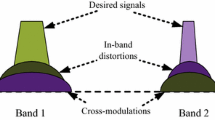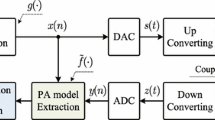Abstract
The nonlinearities of power amplifiers combined with non-contiguous transmissions found in modern, frequency-agile, wireless standards create undesirable spurious emissions through the nearby spectrum of data carriers. Digital predistortion (DPD) is an effective way of combating spurious emission violations without the need for a significant power reduction in the transmitter leading to better power efficiency and network coverage. In this paper, an iterative, multi sub-band version of the sub-band DPD, proposed earlier by the authors, is presented. The DPD learning is iterated over intermodulation distortion (IMD) sub-bands until a satisfactory performance is achieved for each of them. A sequential DPD learning procedure is also presented to reduce the hardware complexity when higher order nonlinearities are incorporated in the DPD learning. Improvements in the convergence speed of the adaptive DPD learning are also achieved via incorporating a variable learning rate and interpolation of previously trained DPD coefficients. A WarpLab implementation of the proposed DPD is also shown with excellent suppression of the targeted spurious emissions.











Similar content being viewed by others
References
White paper: Cisco VNI Forecast and Methodology, 2015-2020. https://www.cisco.com/c/en/us/solutions/collateral/service-provider/visual-networking-index-vni/complete-white-paper-c11-481360.html, (2016).
Staple, G., & Werbach, K. (2004). The end of spectrum scarcity: spectrum allocation and utilization. IEEE Spectrum, 41, 48–52.
Tarazi, I. (2017). Solving The Spectrum Challenge. http://www.federatedwireless.com/solving-the-spectrum-challenge/ Federated Wireless.
Wannstrom, J. (2013). Carrier Aggregation Explained. http://www.3gpp.org/technologies/keywords-acronyms/101-carrier-aggregation-explained. 3GPP.
Khan, Z., Ahmadi, H., Hossain, E., Coupechoux, M., Dasilva, L.A., Lehtomäki, J.J. (2014). Carrier aggregation/channel bonding in next generation cellular networks: methods and challenges. IEEE Network, 28, 34–40.
Ghannouchi, F.M., & Hammi, O. (2009). Behavioral modeling and predistortion. IEEE Microwave Magazine, 10, 52–64.
Park, C.S., Sundström, L., Wallén, A., Khayrallah, A. (2013). Carrier aggregation for lte-advanced: design challenges of terminals. IEEE Communications Magazine, 51, 76–84.
Abdelaziz, M., Fu, Z., Anttila, L., Wyglinski, A.M., Valkama, M. (2016). Digital predistortion for mitigating spurious emissions in spectrally agile radios. IEEE Communications Magazine, 54, 60–69.
Nokia, R4-121205 Way forward for non-contiguous intraband transmitter aspects. Available at: http://www.3gpp.org/, tech. rep., 3GPP (2013).
Nokia, R4-124353, Non-contiguous intraband unwanted emission. Available at: http://www.3gpp.org/, tech. rep., 3GPP (2013).
Lähteensuo, T. (2013). Linearity requirements in LTE advanced mobile transmitter. Master’s thesis. Tampere: Tampere University of Technology.
Braithwaite, R.N. (2013). A combined approach to digital predistortion and crest factor reduction for the linearization of an RF power amplifier. IEEE Transactions on Microwave Theory and Techniques, 61, 291–302.
Roblin, P., Myoung, S.K., Chaillot, D., Kim, Y.G., Fathimulla, A., Strahler, J., Bibyk, S. (2008). Frequency-selective predistortion linearization of RF power amplifiers. IEEE Transactions on Microwave Theory and Techniques, 56, 65–76.
Kim, J., Roblin, P., Chaillot, D., Xie, Z. (2013). A generalized architecture for the frequency-selective digital predistortion linearization technique. IEEE Transactions on Microwave Theory and Techniques, 61, 596–605.
Bassam, S., Helaoui, M., Ghannouchi, F. (2012). Channel-selective multi-cell digital predistorter for multi-carrier transmitters. IEEE Transactions on Microwave Theory and Techniques, 60, 2344–2352.
Abdelaziz, M., Anttila, L., Mohammadi, A., Ghannouchi, F., Valkama, M. (2014). Reduced-complexity power amplifier linearization for carrier aggregation mobile transceivers. In IEEE international conference on acoustics, speech, and signal processing.
Katz, A., Wood, J., Chokola, D. (2016). The evolution of pa linearization: from classic feedforward and feedback through analog and digital predistortion. IEEE Microwave Magazine, 17, 32–40.
Bassam, S., Ghannouchi, F., Helaoui, M. (2011). 2-D digital predistortion (2-D-DPD) architecture for concurrent dual-band transmitters. IEEE Transactions on Microwave Theory and Techniques, 59, 2547–2553.
Dano, M. ATT: We are deploying 3-channel carrier aggregation on LTE network. http://www.fiercewireless.com/wireless/at-t-we-are-deploying-3-channel-carrier-aggregation-lte-network.
Qualcomm, Snapdragon 835 processor specs. https://www.qualcomm.com/products/snapdragon/processors/835.
Abdelaziz, M., Tarver, C., Li, K., Anttila, L., Valkama, M., Cavallaro, J. (2015). Sub-band digital predistortion for noncontiguous transmissions: algorithm development and real-time prototype implementation. In 49th asilomar conference signals, systems, and computers. Pacific, Grove, CA, USA.
Tarver, C., Abdelaziz, M., Anttila, L., Valkama, M., Cavallaro, J.R. (2016). Low-complexity, sub-band dpd with sequential learning: Novel algorithms and warplab implementation. In 2016 IEEE international workshop on signal processing systems (SiPS) (pp. 303–308).
Abdelaziz, M., Anttila, L., Tarver, C., Li, K., Cavallaro, J.R., Valkama, M. (2016). Low-complexity subband digital predistortion for spurious emission suppression in noncontiguous spectrum access. IEEE Transactions on Microwave Theory and Techniques, 64, 3501–3517.
WARP Project. http://warpproject.org.
Acknowledgments
This work was supported by the Finnish Funding Agency for Technology and Innovation (Tekes) under the project “Future Small-Cell Networks using Reconfigurable Antennas (FUNERA).” This work was also supported in part by the US National Science Foundation under grants ECCS-1408370, ECCS-1232274, CNS-1265332, and CNS-1717218 in the WiFiUS program. The work was also funded by the Academy of Finland under the projects 288670 “Massive MIMO: Advanced Antennas, Systems and Signal Processing at mm-Waves,” 284694 “Fundamentals of Ultra Dense 5G Networks with Application to Machine Type Communication,” and 301820 “Competitive Funding to Strengthen University Research Proles,” and by the Linz Center of Mechatronics (LCM) in the framework of the Austrian COMET-K2 program.
Author information
Authors and Affiliations
Corresponding author
Rights and permissions
About this article
Cite this article
Tarver, C., Abdelaziz, M., Anttila, L. et al. Low-complexity, Multi Sub-band Digital Predistortion. J Sign Process Syst 90, 1495–1505 (2018). https://doi.org/10.1007/s11265-017-1303-1
Received:
Revised:
Accepted:
Published:
Issue Date:
DOI: https://doi.org/10.1007/s11265-017-1303-1




